Ich zeige in dieser Rubrik an verschiedenen Paarungen, wie die traditionelle Zucht von Berger des Pyrénées in Frankreich konzipiert war, bevor man seit den 1990er Jahren nur noch Langhaar x Langhaar ( = PL x PL = Poil Long x Poil Long) und Glatthaar x Glatthaar ( = FR x FR = Face Rase x Face Rase) praktiziert hat.
- Beispiel / first example: Jarry de la Grézette (Rüde, Langhaar; *27.06.1974; Rubis du Mont Notre-Dame x Sireine de l’Ourdissétou), Z. Pierre Fontaine, B. Guy-J. Mansencal
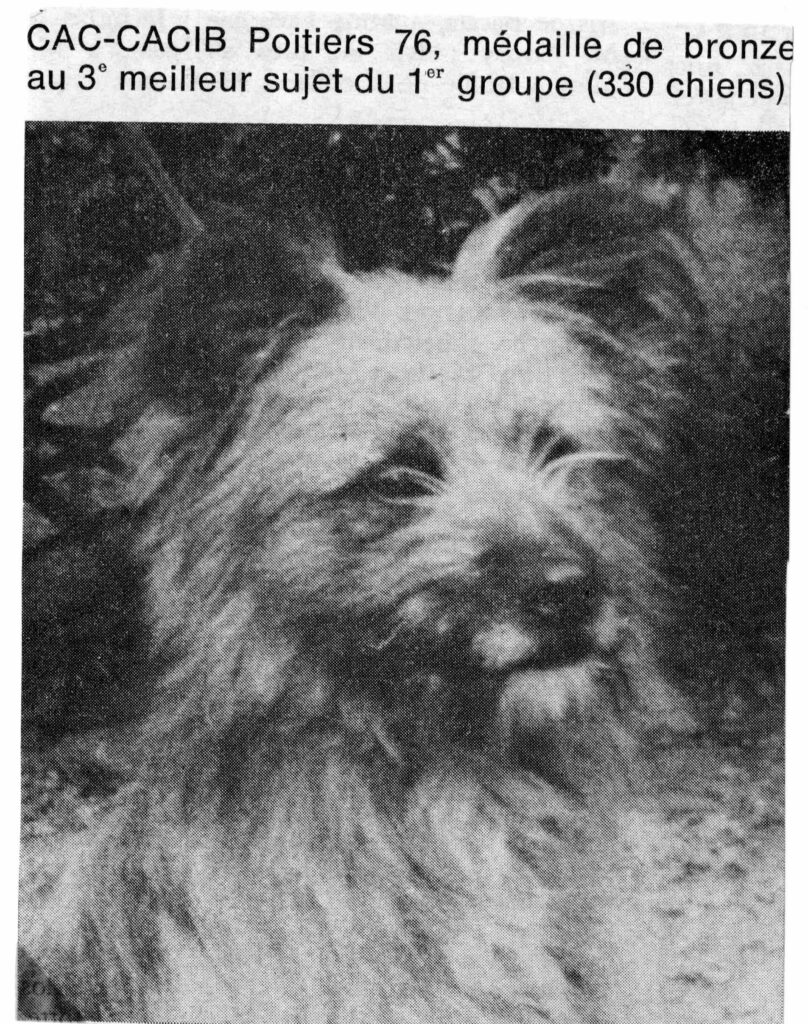
Jarry war u.a. Vater (mit Lorca) von den Schwestern Nonnette (PL), Niclade (PL) und Nectarine (FR)
Jarrys Ausstellungserfolge u.a.: CACIB Poitiers 1976, CAC spéciale Tarbes 1977, CACIB Paris 1977
Jarrys Ahnentafel / pédigrée ( > http://pyrshep.pedigre.net/details.php?id=243 )
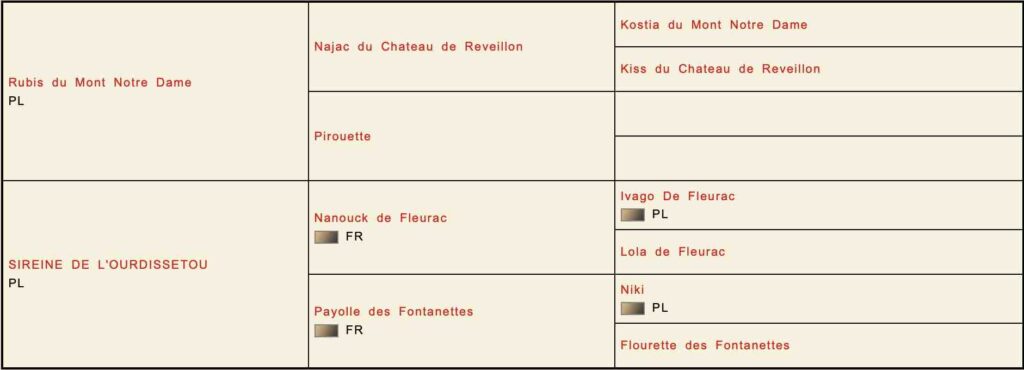
Ergänzung zur AT:
- Sireine de l’Ourdissétou (Registre initial = RI 23988) war nicht PL = Poil Long, sondern FR = Face Rase
- Najac du Ch. de Réveillon war FR (LOF 1314)
- Pirouette war FR (LOF 1364; Messire de Fleurac x Karina du Mont Notre-Dame)
- Die Schwester von Nanouk de Fleurac (LOF 1395) = Nanette de Fleurac war FR
- Kostia du Mont Notre-Dame (LOF 1053) war FR
Die Paarung PL x FR wurde früher viel öfter praktiziert als heute – Jarry ist nur ein Beispiel von vielen (demnächst folgen noch weitere).
Ergebnis damals: Meistens freie Köpfe beim PL > pyrenäischer AUSDRUCK möglich – mittellanges Fell am Körper beim FR;
Ergebnis heute: Meistens verhangene Köpfe beim PL > kein pyrenäischer AUSDRUCK, es sei denn, man frisiert den Kopf – reines Glatthaar auch am Körper beim FR.
…à méditer!
This is very interesting, thank you for sharing! Were both the parents of Sireine face rases? So those kinds of pairings did happen before the 90s but it was rare?
Inga Törnqvist No, it wasn’t rare, it was very frequent: The result of this method for the long-haired BdP > free eyes, chance to show the pyrenean expression; for the FR > to have middle-long coat on the body. The result of the current method for the long-haired BdP > Eyes mostly invisible, only after artificial intervention by the owner (tune up the abundance of hair, otherwise no pyrenean expression). The result for the FR > smooth coat on the body. The current method is a reversal of the traditional method from the very beginning till the 1990ies… It’s a perversion!
Josef Müller seeing the expression, seeing the shape of eyes and seeing the hair blow back is so very important. I cannot understand why hairly faces are being rewarded in the show ring or are desired in the whelping box.
Josef Müller I meant the FR to FR pairings being rare before 90’s? I can’t help but wonder why the method of breeding changed. Why now the PL and FR are so separated. Sometimes even seeing dogs that lack that Pyrenean expression that made me fall for the breed in the first place. In Sweden crossing FR and PL was allowed only a few years ago, in 2018.
I took the freedom to change the things you noted that was missing/incorrect in the international database, hope that is ok. Thanks again for sharing your knowledge of the history of the breed! Even though I’m not a breeder, just a happy amateur, I’m always happy to learn more about this breed!
FR x FR-pairings were rare before 1996, the first pure FR-breeder (to my knowledge) was Ariane Faucillon-Vaucher in Switzerland: She needed avalanche dogs… Although she is a very great connoisseur she didn’t succeed in breeding a clear type of FR (in my eyes, her production was too heterogenous). 1996, Charles Douillard published an essential contribution about FR which incited me to begin with FR x FR-pairings. Since I had some successors in this direction, I retired from breeding FR because the longhaired are much more exciting to breed (in my opinion). Later on, I remembered that the pure mating of FR x FR was not in the line of pyrenean tradition, I changed once more the direction… The radical separation of PL and FR is due to a modification of the standard made by Alain Pécoult in 2000/2001. He defined the phenotype of FR in a way that intensifies the differences between PL and FR instead of diminishing them: Divergency instead of convergence. Divergency is stacked against both – against the PL because the pyrenean expression needs free eyes; against the FR because the pool is not very big and they lack elegance, in my opinion, the now preferred type is rather clumsy…
Inga Törnqvist FR was not very clearly defined before 1996: The third president of the RACP and the then-secretary of RACP, Guy-J. Mansencal, engaged his Romarin de l’Estaubé in the first National Show of the RACP at Poitiers 1982 as middle-long, the judge and the then-president of the RACP, Charles Duconte, transferred Romarin to FR and he made him Best FR… To speak in genetics, f/f is Piémont in the definition of Douillard = smooth-haired all over the body (exception for culottes etc.),the traditional FR was f/F2 – and this formula could give traditional FR and typical middle-long haired BdP. In ancient eyes, the parents of Sireine may have been considered as well as FR or as middle-long… Breeders then didn’t care so much about this question… In the 1920ies, the great breeders such as Bernard Sénac-Lagrange had about 20 BdP in their kennels, 3-5 ware declared (!) as FR…
2. Beispiel / second example: Idrac de l’Estaubé (Rüde / sire, Langhaar / long-haired; *16.12.1973; Soulor de l’Estaubé x Urfa), Z. Guy-J. Mansencal
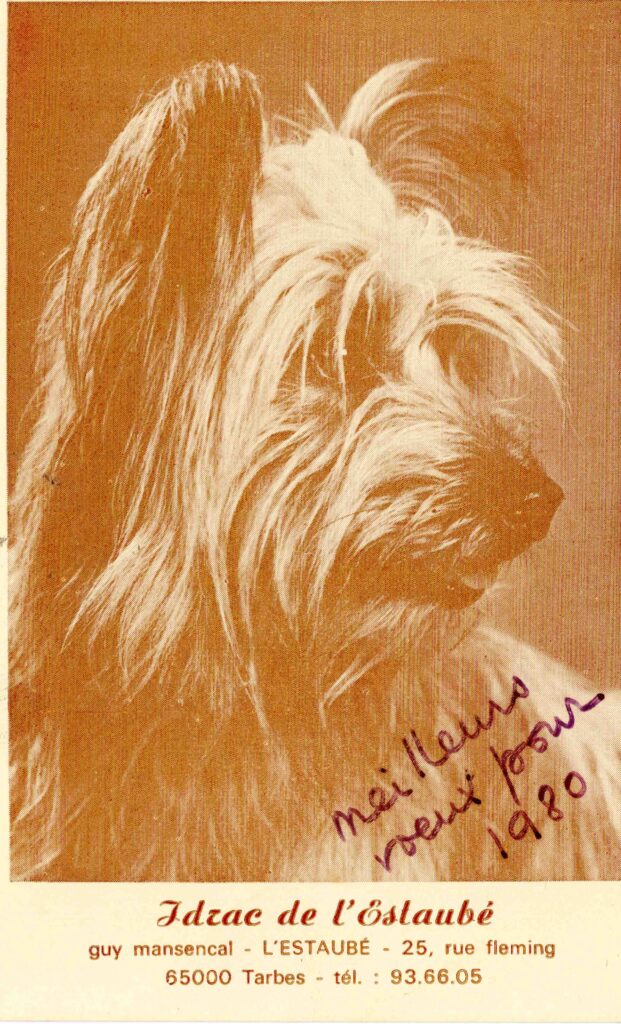
Idracs Ahnentafel / pédigrée ( > http://pyrshep.pedigre.net/details.php?id=243 )
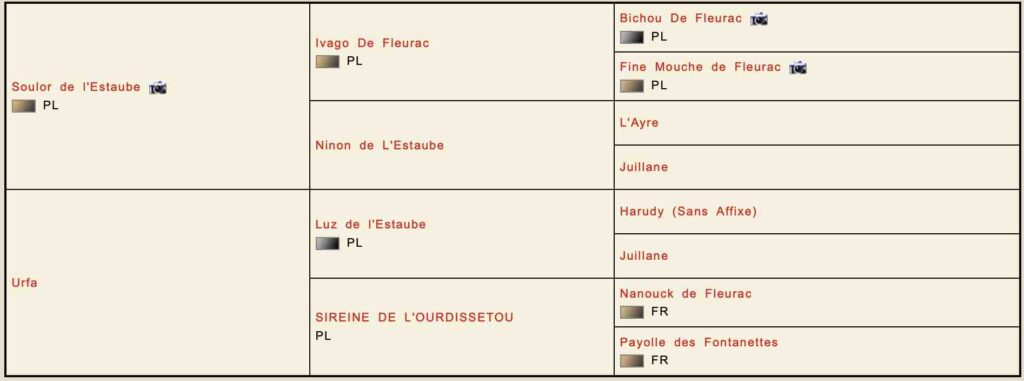
Ergänzung zur AT:
- Urfa = FR
- Sireine de l’Ourdissétou (Registre initial = RI 23988) war nicht PL = Poil Long, sondern FR = Face Rase
3. Beispiel / third example: Oulettes (de Boun-Néou) (Hündin / female, Langhaar / long-haired; Ri. 20156; Luz de l’Estaubé x J’Véga), Z. Mme Boneu, B. Guy-J. Mansencal
Vater: Langhaar / PL ; Mutter: Glatthaar / FR
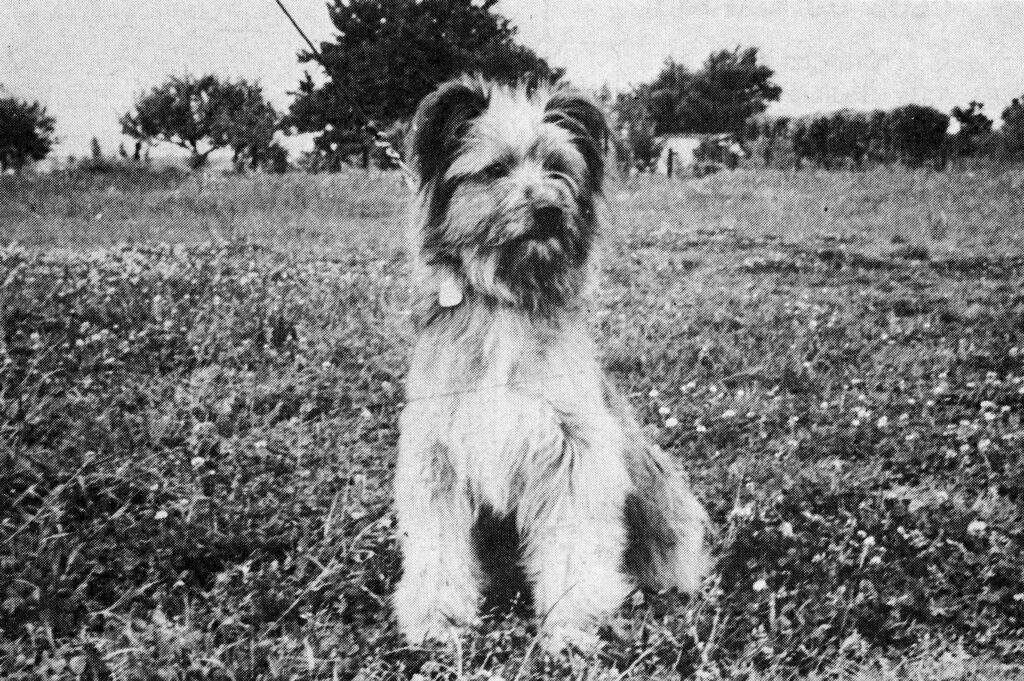
Oulettes‘ Ahnentafel / pédigrée ( > http://pyrshep.pedigre.net/details.php?id=243 )
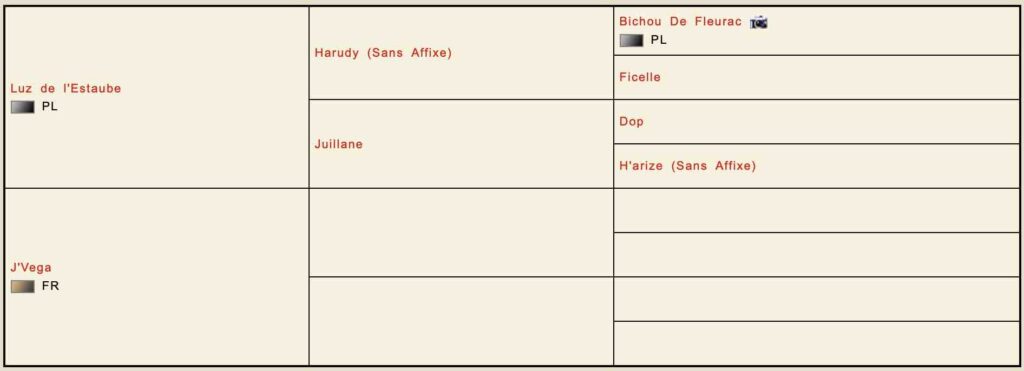
4. Beispiel / 4th example: Pierrot Bleu (Rüde / sire, Langhaar / longhaired und Pyrène de l’Estaubé (Hündin / female, Langhaar / long-haired; Muscadin x O’Estaubé), Z. Guy-J. Mansencal, B. Mlle de Saint-Anthost
Vater: Langhaar / longhaired ; Mutter: Glatthaar / FR
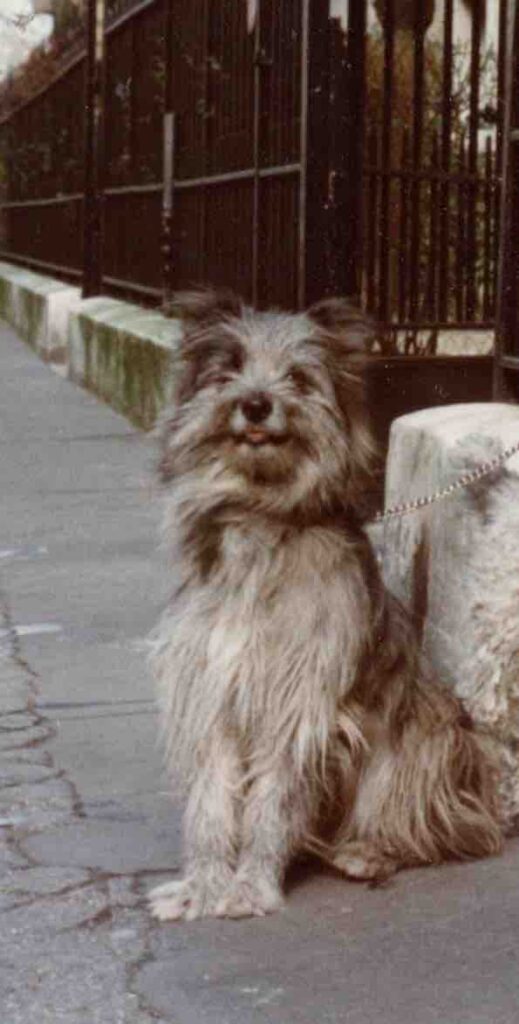
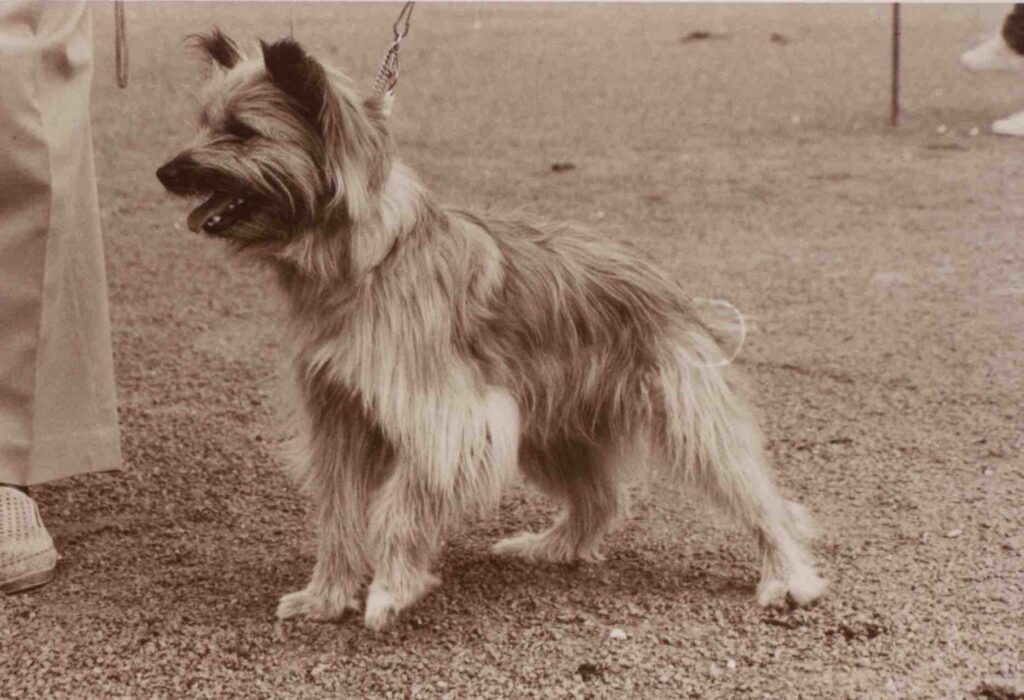
Ahnentafel / pédigrée von Pierrot Bleu und Pyrène ( > http://pyrshep.pedigre.net/details.php?id=243 )
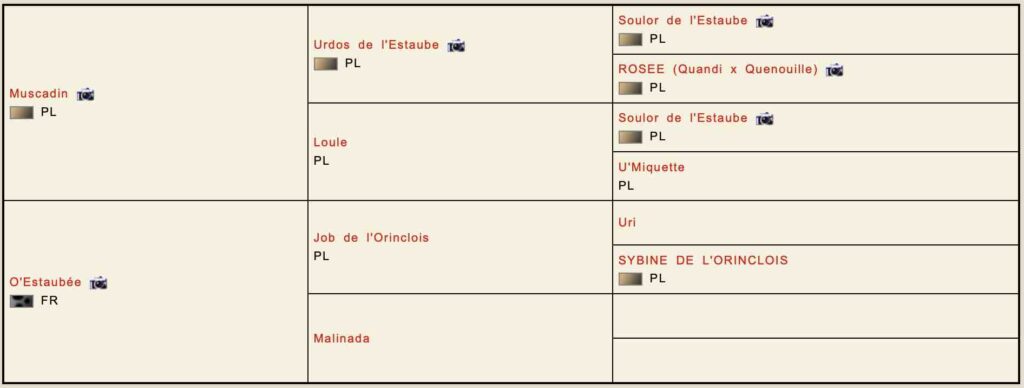
Ergänzung zur AT:
Uri = Luz de l’Estaubé (longhaired) x Sireine de l’Ourdissétou (FR)
5. Beispiel / 5th example: Tarquin le Superbe (Rüde / sire, Langhaar / longhaired; Orme x Puce), Z. ?; B. Guy-J. Mansencal
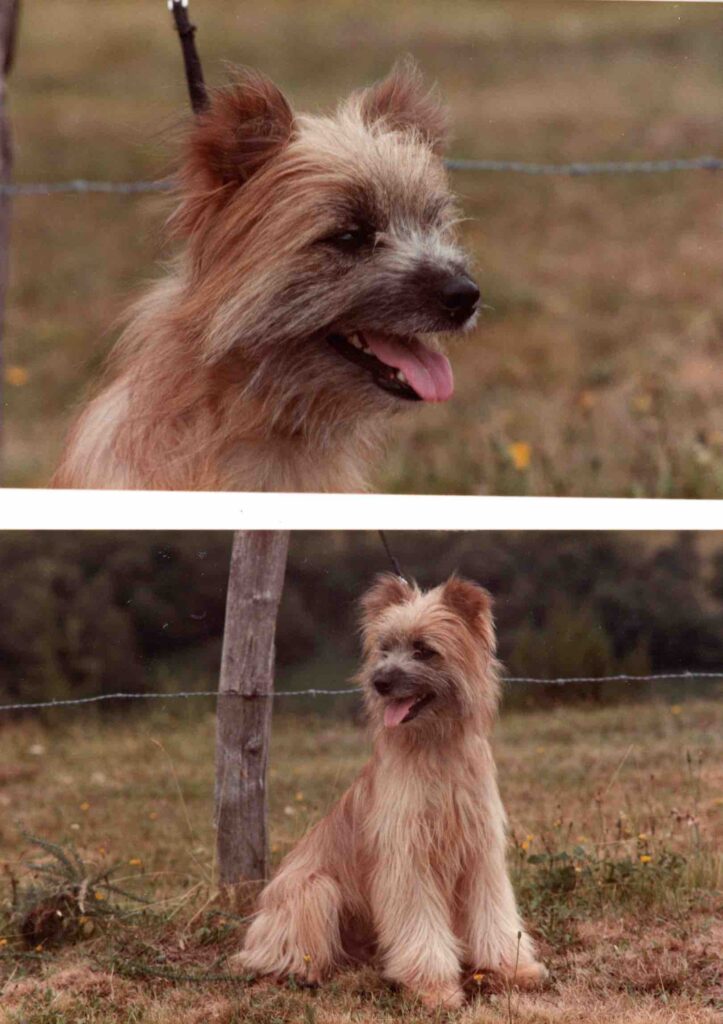
Vater: Sehr langhaarig; Mutter: Langhaar; Tante Nubie mütterlicherseits: FR
Ahnentafel / pédigrée von Tarquin le Superbe ( > http://pyrshep.pedigre.net/details.php?id=548 )
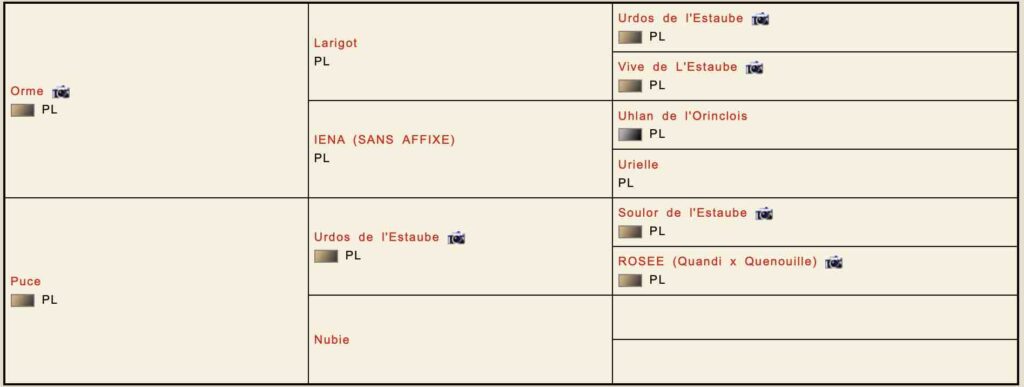
6. Beispiel / 6th example: „Vous finirez par faire des FaceRase…“ Mit der pyrenäischen Paarungsmethode sterben auch die FR nicht aus… Damit muss der Langhaar-Züchter leben… Vater = Langhaar / longhaired; Mutter: Langhaar / longhaired; Tante mütterlicherseits = FR…
Tourmalet Bleu de l’Estaubé (Rüde / sire, Glatthaar / FR; Muscadin x Réglisse de l’Estaubé), Z. Guy-J. Mansencal, B. Jean-Claude & Gerda Person
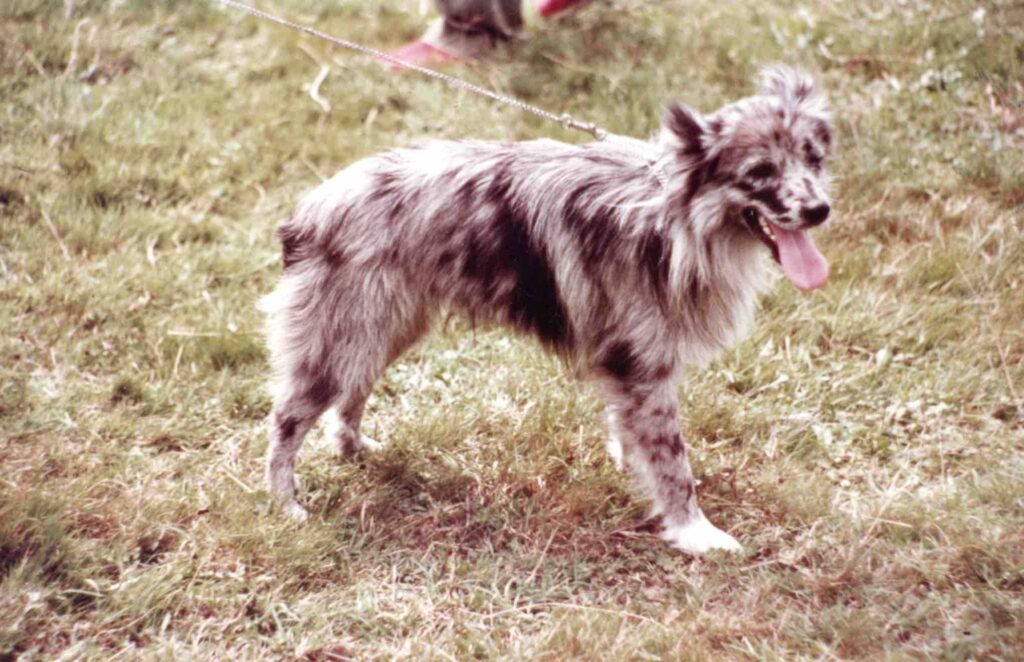
Ahnentafel / pédigrée von Tourmalet Bleu de l’Estaubé ( > http://pyrshep.pedigre.net/details.php?id=1519
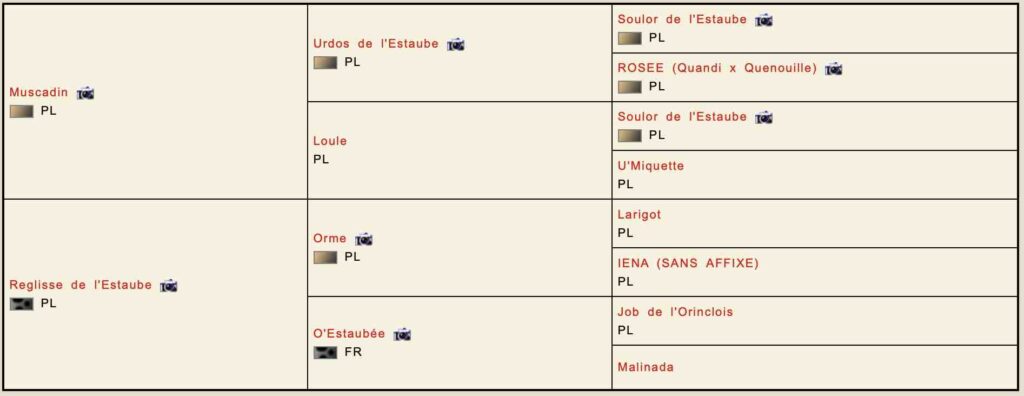
7. Beispiel / 7th example: „Vous finirez par faire des FaceRase…“ Mit der pyrenäischen Paarungsmethode sterben auch die FR nicht aus… Damit muss der Langhaar-Züchter leben… Vater = Langhaar / longhaired; Mutter: Glatthaar / FR
Xampan (Rüde / sire, Glatthaar / FR und Xarel-lo vom Wunderhorn (Hündin / female, Langhaar / long-haired; Malik de la Petite Noire x Trimbareilles vom Wunderhorn), Z. Claudia & Josef Müller, B. …
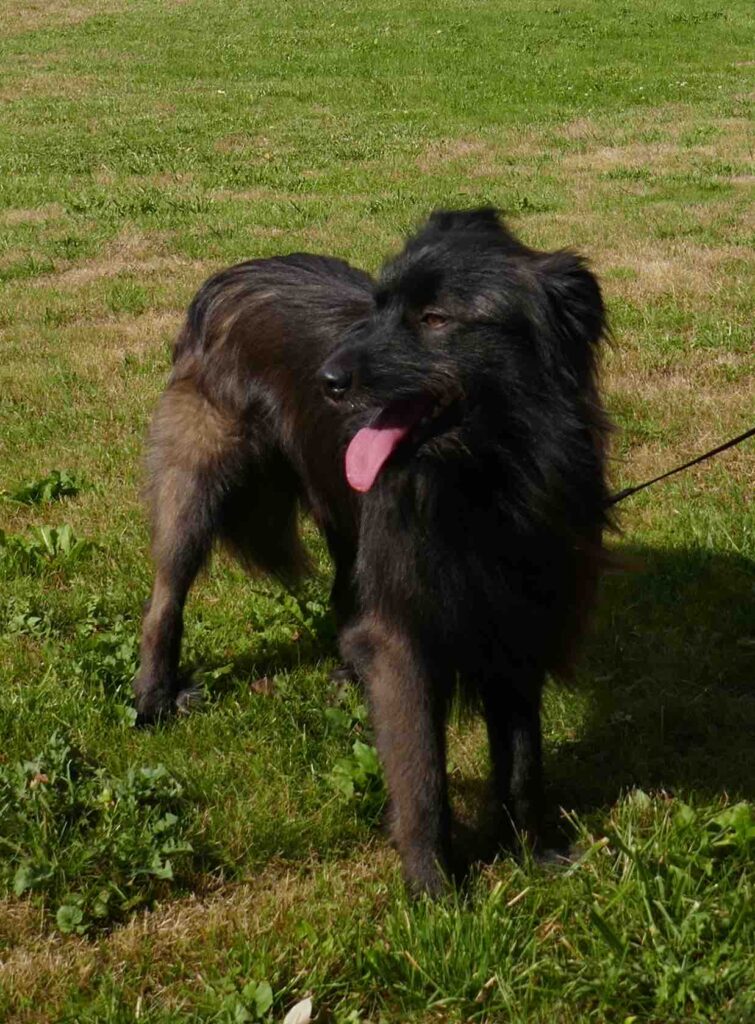
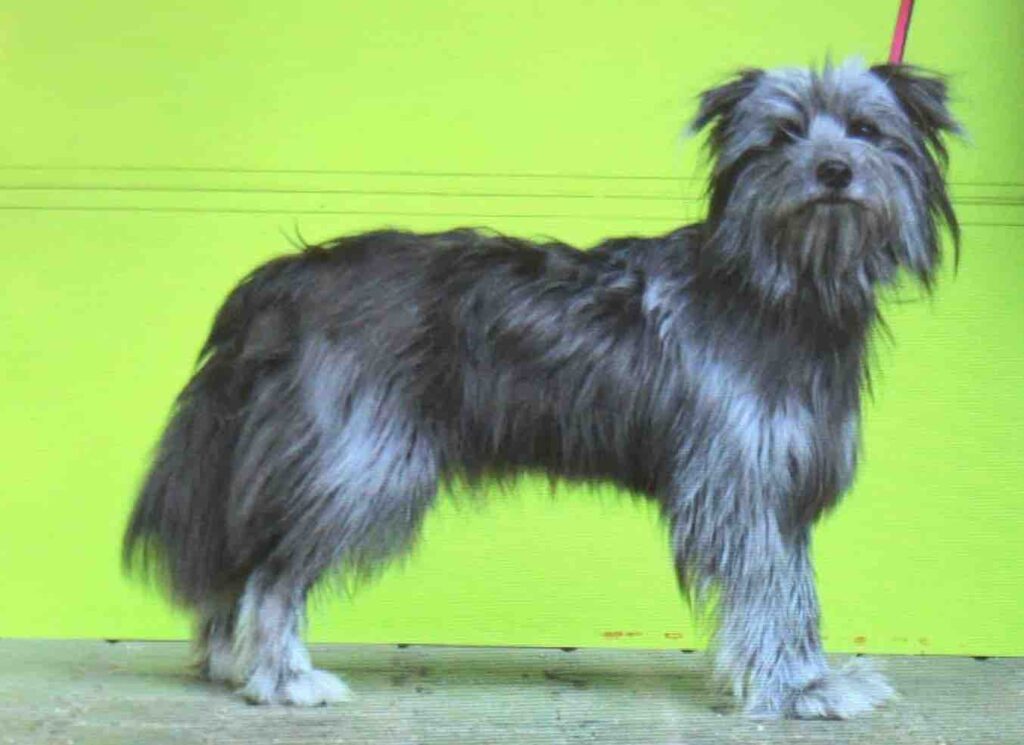
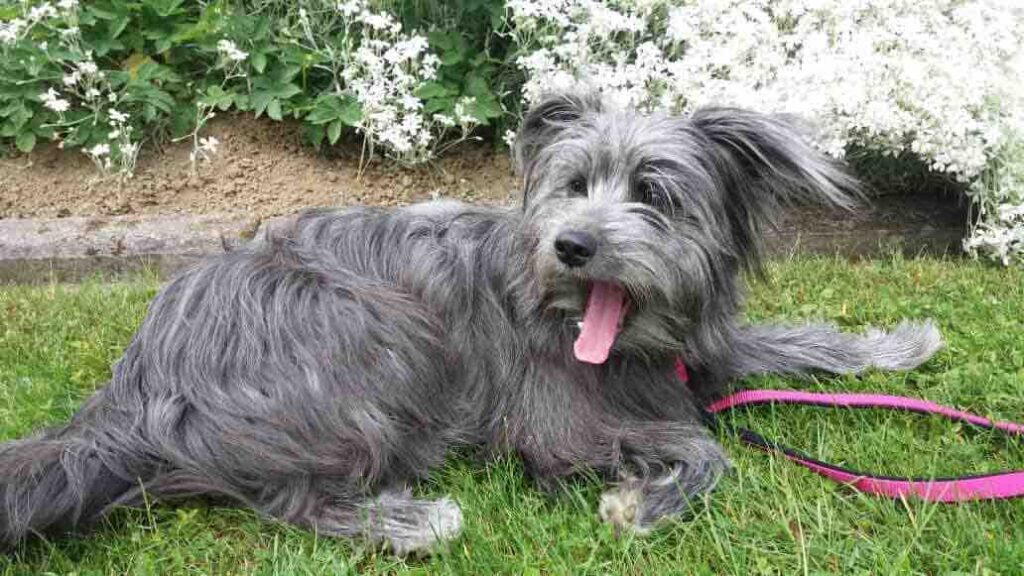
Ahnentafel / pédigrée von Xampan und Xarel-lo vom Wunderhorn
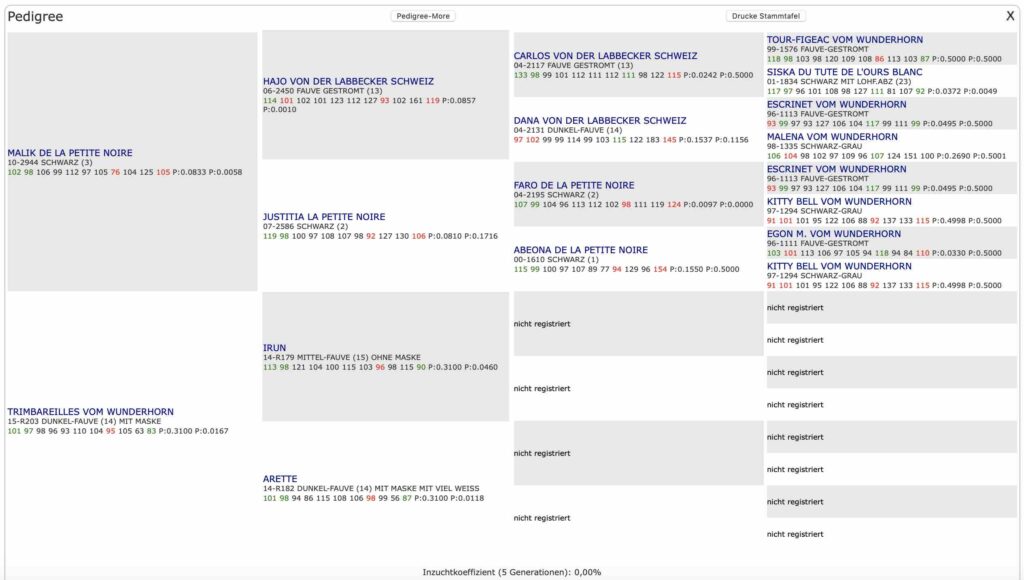
Preamble: This article has been written prior to the discovery of the 3rd allele on the RSPO2-Locus…
Rethinking the Face Rase variety – Two wrongs, and one right. *
Keep in mind that the differentiation between the two types/varieties/breeds (free to choice of notion) at the time they were recognized by the FCI speaks mainly of the head, more precisely of its hair length on the head. The term “face rase” was defined literally as “short hair on the face” (“short” in the Pyrenean sense as being smooth – and not the understanding of the genetics Locus FGF5).
The face does not include the skull, it is only the face. The early authors of the Standard reduced this area of difference between the two varieties even further by describing the long-haired brother as “Museau Normal = MN = Normal Muzzle” . Only the dog’s muzzle was described as displaying a long, hairy moustache and a beard on the chin as being “normal”, not the whole face. This hair on and around the muzzle was clearly the most significant difference between the FR (without these features) and the MN (with these features).
We must now add the next principal difference between the Face Rase (Smooth Faced) and the Museau Normal (not so “smooth”) . A Face Rase has no eyebrows, or only a very slight hint of eye brows, while a face not so “rase” has eye-brows. All the other differences mentioned in the “annex” of the Museau Normal Standard concerning the morphological and body coat features of the Face Rase are considered less important than this first principal difference mentioned in the initial remarks of the text supplement (called annex). And note that the word “normal” is strictly defined only in a quantitative sense referring to a majority of the race, and not that the Face Rase is considered abnormal.
Considering this, at first glance, with a cynological and philological approach to the terms “Face Rase” and “Museau Normal”, why do I speak of “two wrongs”?
My first mistake – from 1974 to 1995: The Face Rase is a NO-Breed.
Well, the first mistake I made was at the very beginning of my occupation with the Berger des Pyrenees and lasted for 21 years. From 1974 until 1995 I made the mistake of thinking of the Face Rase as a NO-Breed.
The first specimens of the Face Rase I saw at the French National Specialty Shows were very heterogeneous in phenotype and I could not detect any consistency or unity. Every breeder seemed to be producing what he understood to be examples of the FR, usually a by-product from litters by the rough-faced variety breedings (that already left a bad taste in my mouth being the neophyte I was at the time – long ago).
Not only did they lack unity in phenotype, they were really very common looking, even somewhat clumsy. But, to be honest, I must mention the fact that the breeders’ qualities and abilities were also somewhat heterogeneous as well. My perspective was that of an aficionado of the Museau Normal variety and I admit it was simply unfair of me at that time. I hated the FR and I said it frankly to Guy-J. Mansencal who predicted to me: “Vous finirez par faire des Face Rase!” (“You will have FR in your litters whether you want it or not!”) This was a hint that the Pyrenean matings at that time, and generally in Pyrenean tradition, were clearly heterozygeous in the sense of the Locus RSPO2, the matings were mostly Ff x Ff, perhaps sometimes FF x ff, but rarely FF x FF (given the loss of expression by veiled eyes; only in the recent decades are they mating FF with FF in order to create the Pyrenean Puli with a homozygosity on the Locus KRT71 for curly hair = cadenettes). So, I did everything to avoid the production of Face Rase! In doing that, I was so successful that I wasn’t able to produce Face Rase when I finally WANTED it! Look at Deus ex M.vom Wunderhorn for instance.
He was intended as FR, but I had no immediate success using him for producing Face Rase and it was only in the next generation did a convincing Face Rase appear: His son Apollo vom Hause Zerrath.
My second mistake – from 1995 to 2015: The Face Rase is ANOTHER breed.
In 1995, Charles Douillard came along suddenly, and not at all expected, with his project to complete a Standard for the Face Rase whom he called “Piémont”. For me, this project revealed the chances for a clear breeding of Face Rase as an autonomous breed which had to be evolved out of the long-haired population, but not in the sense of the long-haired morphology. A constructive view on the Face Rase seemed only possible with a clear division into two populations, two different breeds.
Douillard set the priorities for ANOTHER BREED by emphasizing the differences first in the head structure, then in the height at the withers. Concerning the height, Douillard proposed to suppress the small Face Rase and to begin the height at 45cm. He clearly favored the Face Rase above 50cm and wanted mostly the maximum in order to fill the gap between the Pyrenean and the other French herding dogs beginning at 55cm. Not only was breed being defined by height at the withers, but also in the structure of the head. Douillard veered away from the typical Pyrenean feature of a bear-like head structure which was desired from the very beginning for both of the shepherd’s pastoral breeds, the Great Pyrenees and the Pyrenean Shepherd. Instead of the old Pyrenean ratio of 60:40 (skull – snout) which gives a broad triangle, Douillard favored a ratio around 55:45 as is often seen today in the Smooth-Face, and even 50:50 which is the ratio for the French shepherd dogs of the plains (the Briard, Beauceron and Picard – two interlaced rectangles building the typical head of these breeds of the plains). Given that the head is always seen as the signature of a breed, Douillard betrayed the Pyrenean origin of the breed.
Nevertheless, Charles Douillard gave us new and deeper insights into the real morphology of the Face Rase whom he called Piémont – with this new labeling, he was once more shifting the “new” breed out of the Pyrenean chain and into the lowlands where Pyrenean mythology such as bear-ceremonial mythology was not practiced in earlier centuries. These new insights were as follows. The Face Rase is NOT built in a square, but in a rectangle. His croup is NOT flat but inclined harmoniously to the hip. The angulation of the hind quarters is NOT straight but well angulated – not too much but in comparison to the MN BdP it is still obviously angulated. These last mentioned insights led me, over the years, to a new judgment of the real Face Rase.
Golden Gate to Wisdom – from 2015 to 2018: FR is the SAME breed!
Take the first authors of the standard seriously, take these pioneers literally! And re-read the introduction of my new statement! There are only very FEW differences between the long-haired, the semi-long-haired Berger des Pyrenees and the Face Rase Berger des Pyrenees. The genetical difference is located on the Locus RSPO2. ONE allele which decides over Smooth or Rough and the heterozygous state “Ff” allows the expression of TWO Pyrenean types: the demi-long-haired Berger des Pyrenees and the traditional Face Rase Berger des Pyrenees, whereas the homozygous FR (whom we call in Germany and honor Charles Douillard the “Piémont-Type”) is equipped with “ff”.
Breeders! Let us diminish the morphological differences existing between the Face Rase and the Museau Normal. „The snout may be a little bit longer than that of the Museau Normal“ – is it perhaps only the lack of chin hair and moustache which influences our eyes: An optical illusion? „The body is a little bit shorter than that of the Museau Normal“ (Standard 1923) – I would even prefer the standard’s authors had said: a little bit less long. The Museau Normal is not short in body length. He is built in an accentuated rectangle of 8-10% longer than high at the withers. Many of our Face Rase in Germany are 8% longer than high and yet they appear to be built in a square: Nanuk du Petit Filou illustrates this optical illusion. The smooth croup of our Face Rase (contrary to the sharp croup of the actual French Face Rase) shortens a really long body and lets it appear as a square. And finally, the height at the withers. „40cm-54cm for the males and 40cm to 52cm for the females.“ Since the Standard for the Museau Normal has augmented the minimum from 38cm to 40cm for the females, the minimum is for both varieties the same. And the maximum?? Don’t forget that the very first Standard (not recognized) allowed a maximum of 55cm for both varieties. Only the later versions created the differences in the height at the withers between the Face Rase and the Museau Normal.
Let us diminish also the mental differences claimed in the Face Rase Annex of the Standard: Less “nervous” and more biddable than the Museau Normal, less distrustful to strangers. This is claimed to be a substance but it may be an accidence. The Face Rase was more often guided by professionals and maquignons (drovers of mixed and recently composed flocks). It is not a miracle that these dogs, under their influence, etc., show more self-confidence!
Our approach to the Face Rase as the SAME breed allows us to mate FR and Piémont with Museau Normal (Rough-faced) Bergers des Pyrenees without being caught in the trap of different morphologies (features which I cited above). “Cross” matings will be for the sake of the Pyrenean expression in the Museau Normal too. It will be a win-win! And a return to traditional Pyrenean breeding practices.
Let us benefit from the fact that the first authors of the Standard mentioned these apparent differences between the FR and the “other” Berger des Pyrenees in a particular order, that is, the order of importance. Guess why they did so?? I gave you some hints. Give some thought to it! Thank you.
* I am grateful that Susan Buttivant refined my poor English!